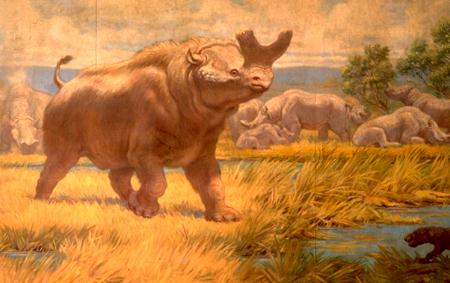 |
 |
 |
 |
 |
Produced
by the Population Genetics and Evolution class, Furman University |
||||
 |
 |
 |
 |
 |
Produced
by the Population Genetics and Evolution class, Furman University |
||||
 |
The
Paleogene: Brontotherium and the Titanotheres |
 |
||
| The Brontotheres,
also known as Titanotheres, are extinct, distant relatives of the modern
horse, although their appearance was closer to that of rhinoceroses (Myers
2010). They were presumably herbivorous, quadrupedal ungulates (Stanley
1973). Fossils place them at eight fee tall, or slightly smaller than
modern elephants. Brontotheres primarily inhabited regions of North America
and likely became extinct during the transformation of forestland to grassland
(Schaeffer 2010). The most remarkable feature of the Brontotheres is the two-pronged protuberance on the snout. This feature’s evolution began, presumably, in Eocene forms of the Brontothere that developed small, symmetrical swellings on the snout. Through exaptation, possibly as a means of combat whether for mates or against predators, this allometry was maintained and amplified through evolutionary history into the bony horns and curved, sturdy skull of the most recent fossils (Stanley 1973). Page by Will Towler |
 |
| Brontotherium. Picture From: hiddenaway.tripod.com | |
|
Myers W. 2010. Cenozoic Earth – Brontotherium. Accessed April 12, 2010. Stanley S. 1973. Relative growth of the Titanothere horn: a new approach to an old problem. Evolution. 28:447-457. Schaeffer, Don. 2010. Titanotheres. Judith River/White River Fossils. Accessed April 12, 2010. |